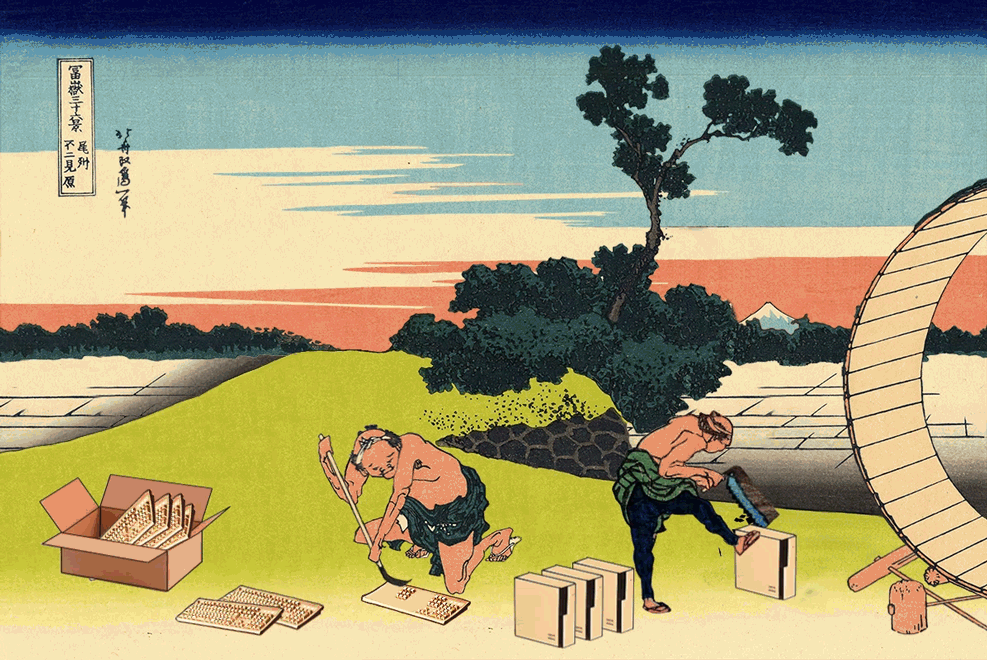
NEC’s creative collaboration with digital artist Atsuki Segawa shows us what it might have looked like if computers existed in Japan during the Edo Period!
We’ve previously introduced on our site the unique art produced by Segawa, who also works under the name Sanjushichi Segawa. Once again, he’s brought some ukiyo-e drawings to life, this time in a promotional campaign by information technology company NEC for their line of LAVI computers.
Segawa’s GIF animations, which can be seen on NEC’s special campaign site, feature LAVI products in scenes from Edo Period Japan (1603–1868) and are based on ukiyo-e works by masters such as Katsushika Hokusai and Utagawa Hiroshige.
And now, without further ado, let’s take a look at the moving art that incorporates computers into life during the Edo Period:
1. Christmas Shopping
This piece is based on Utagawa Hiroshige’s depiction of the Goyu-shuku post station among the 53 Stations of the Tōkaidō Route (Tōkaidō Gojusantsugi Goyu). It shows the town decorated in Christmas lights with LAVI products being promoted as holiday presents at the storefront. The narrow wooden signs hanging in the shop have advertising written on them in small letters, such as “Most lightweight in the world”, “Records up to four programs” and “High definition display”.
2. The Digital Terakoya (School)
This picture which shows children studying in what appears to be a classroom setting is based on Utagawa Kunisada’s work Osanarikugei no Uchi, Sho Sū, a title which indicates that in the original painting, children are studying calligraphy (sho) and math (sū) among the six basic necessary children’s educational subjects (osanarikugei). The scene is what you might expect to see in a typical terakoya, private institutions that offered education to the public during the Edo period. Interestingly, the problem shown on the large monitor on the desk is an actual geometry question (yes, it can actually be solved!) that was submitted as a mathematical offering in 1811 to the Haruna Shrine in Gunma Prefecture about 100 kilometers northwest of Tokyo.
3, New Product Launch
This piece is based on a painting that is instantly recognizable to most people in Japan, the Taisen hokan-zu, which captures an immensely important moment in Japanese history. The original paining by Tanryo Murata depicts the event that occurred in 1867 known as Taisei Hokan, in which political power was formally restored to the Emperor from the Tokugawa Shogunate that ruled Japan during the Edo Period, signifying the end of the age of the shoguns. (To be precise, the painting apparently shows the Shogun on the day before the actual Taisei Hokan, but this is the picture that Japanese people think of when we talk about the event.) But here, Segawa has turned the historic occasion into a presentation for new product launch — quite amusing and very 21st century!
4. Made in Japan
In this picture, Segawa whimsically shows workers cutting out keyboards and computers from wood, possibly symbolizing the high regard in which craftsmanship is held in Japan. This piece is based on one of the Thirty-six Views of Mount Fuji (Fugaku Sanjūrokkei) prints created by Katsushika Hokusai, specifically the one titled Fuji View Field in Owari Province (Bishū Fujimigahara). Additionally, Segawa has included elements from another of Hokusai’s Mount Fuji prints, Honjo Tatekawa, which also depicts men hard at work.
5. Valentine’s Day
This picture based on one of the works by Utagawa Kunisada from his Isegoyomi Mitate Jûnichoku series of prints, in which he associates the Twelve Correspondences (jûnichoku) relating to calculations of lucky and unlucky days in Edo astronomy with the twelve months of the year. The full title of Kunisada’s original work is quite a mouthful — Ise Goyomi Mitate Jûnichoku Toru Gokugetsu no Mochitsuki Reki Chûdan Tsukushi (Making Rice Dumplings in the Twelfth Month from the series Scenes for the Twelve Correspondences According to the Ise Almanac, Middle Section), but it seems like Segawa had a bit of fun researching for this piece, as he says he went to multiple stores to buy chocolates and sweets, which he has drawn in here instead of the mochi rice dumplings in the original. And, naturally, the ladies in the picture are referring to a recipe for the sweet treats on their tablet device!
So, how did you like the playful moving works of art showcasing computers in the Edo Period? If Segawa’s animations are to your liking, there will be a few more of them released on NEC’s LAVI campaign site in the near future, so you might want to follow the site for updates. We hope you enjoy the artistic virtual trip back in time!
Source: LAVIE in EDO website via ARTIST DATABASE
All images: LAVIE in EDO website





 These 19th-century Japanese miniature landscapes show that size isn’t everything
These 19th-century Japanese miniature landscapes show that size isn’t everything Own the lighter side of ukiyo-e with a zodiac chimera and weird tiger-stone items by Felissimo
Own the lighter side of ukiyo-e with a zodiac chimera and weird tiger-stone items by Felissimo Converse All-Stars team up with two all-stars of Japanese art for Wave, Skull ukiyo-e shoes【Pics】
Converse All-Stars team up with two all-stars of Japanese art for Wave, Skull ukiyo-e shoes【Pics】 Tokaido ukiyoe series by Hiroshige now free to share, we celebrate with five favourites
Tokaido ukiyoe series by Hiroshige now free to share, we celebrate with five favourites Get your beer in artistic cans featuring work by ukiyoe master Hiroshige!
Get your beer in artistic cans featuring work by ukiyoe master Hiroshige! McDonald’s new Happy Meals offer up cute and practical Sanrio lifestyle goods
McDonald’s new Happy Meals offer up cute and practical Sanrio lifestyle goods Starbucks reopens at Shibuya Scramble Crossing with new look and design concept
Starbucks reopens at Shibuya Scramble Crossing with new look and design concept More foreign tourists than ever before in history visited Japan last month
More foreign tourists than ever before in history visited Japan last month Is the new Shinkansen Train Desk ticket worth it?
Is the new Shinkansen Train Desk ticket worth it?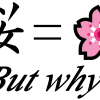 How to write “sakura” in Japanese (and why it’s written that way)
How to write “sakura” in Japanese (and why it’s written that way) Our reporter takes her 71-year-old mother to a visual kei concert for the first time
Our reporter takes her 71-year-old mother to a visual kei concert for the first time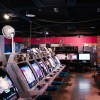 Tokyo’s most famous arcade announces price increase, fans don’t seem to mind at all
Tokyo’s most famous arcade announces price increase, fans don’t seem to mind at all Foreign English teachers in Japan pick their favorite Japanese-language phrases【Survey】
Foreign English teachers in Japan pick their favorite Japanese-language phrases【Survey】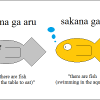 Seven mistakes foreigners make when speaking Japanese—and how to fix them
Seven mistakes foreigners make when speaking Japanese—and how to fix them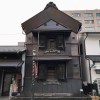 Enjoy a Japanese tea ceremony in a traditional storehouse
Enjoy a Japanese tea ceremony in a traditional storehouse Disney princesses get official manga makeovers for Manga Princess Cafe opening in Tokyo
Disney princesses get official manga makeovers for Manga Princess Cafe opening in Tokyo We try out “Chan Ramen”, an underground type of ramen popular in the ramen community
We try out “Chan Ramen”, an underground type of ramen popular in the ramen community Beautiful new Final Fantasy T-shirt collection on the way from Uniqlo【Photos】
Beautiful new Final Fantasy T-shirt collection on the way from Uniqlo【Photos】 There’s a park inside Japan where you can also see Japan inside the park
There’s a park inside Japan where you can also see Japan inside the park New Studio Ghibli bedding sets are cool in all senses of the word
New Studio Ghibli bedding sets are cool in all senses of the word Japanese convenience store packs a whole bento into an onigiri rice ball
Japanese convenience store packs a whole bento into an onigiri rice ball Hanton rice — a delicious regional food even most Japanese people don’t know about, but more should
Hanton rice — a delicious regional food even most Japanese people don’t know about, but more should New Pokémon cakes let you eat your way through Pikachu and all the Eevee evolutions
New Pokémon cakes let you eat your way through Pikachu and all the Eevee evolutions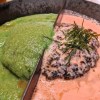 Hamburg and Hamburg Shibuya: A Japanese restaurant you need to put on your Tokyo itinerary
Hamburg and Hamburg Shibuya: A Japanese restaurant you need to put on your Tokyo itinerary Studio Ghibli releases Kiki’s Delivery Service chocolate cake pouches in Japan
Studio Ghibli releases Kiki’s Delivery Service chocolate cake pouches in Japan Japan’s bone-breaking and record-breaking roller coaster is permanently shutting down
Japan’s bone-breaking and record-breaking roller coaster is permanently shutting down New definition of “Japanese whiskey” goes into effect to prevent fakes from fooling overseas buyers
New definition of “Japanese whiskey” goes into effect to prevent fakes from fooling overseas buyers Foreign passenger shoves conductor on one of the last full runs for Japan’s Thunderbird train
Foreign passenger shoves conductor on one of the last full runs for Japan’s Thunderbird train Our Japanese reporter visits Costco in the U.S., finds super American and very Japanese things
Our Japanese reporter visits Costco in the U.S., finds super American and very Japanese things Kyoto bans tourists from geisha alleys in Gion, with fines for those who don’t follow rules
Kyoto bans tourists from geisha alleys in Gion, with fines for those who don’t follow rules Studio Ghibli unveils Mother’s Day gift set that captures the love in My Neighbour Totoro
Studio Ghibli unveils Mother’s Day gift set that captures the love in My Neighbour Totoro Domino’s Japan now sells…pizza ears?
Domino’s Japan now sells…pizza ears? New Japanese KitKat flavour stars Sanrio characters, including Hello Kitty
New Japanese KitKat flavour stars Sanrio characters, including Hello Kitty Kyoto creates new for-tourist buses to address overtourism with higher prices, faster rides
Kyoto creates new for-tourist buses to address overtourism with higher prices, faster rides Sales of Japan’s most convenient train ticket/shopping payment cards suspended indefinitely
Sales of Japan’s most convenient train ticket/shopping payment cards suspended indefinitely Sold-out Studio Ghibli desktop humidifiers are back so Totoro can help you through the dry season
Sold-out Studio Ghibli desktop humidifiers are back so Totoro can help you through the dry season Japanese government to make first change to romanization spelling rules since the 1950s
Japanese government to make first change to romanization spelling rules since the 1950s Ghibli founders Toshio Suzuki and Hayao Miyazaki contribute to Japanese whisky Totoro label design
Ghibli founders Toshio Suzuki and Hayao Miyazaki contribute to Japanese whisky Totoro label design Doraemon found buried at sea as scene from 1993 anime becomes real life【Photos】
Doraemon found buried at sea as scene from 1993 anime becomes real life【Photos】 Tokyo’s most famous Starbucks is closed
Tokyo’s most famous Starbucks is closed One Piece characters’ nationalities revealed, but fans have mixed opinions
One Piece characters’ nationalities revealed, but fans have mixed opinions We asked a Uniqlo employee what four things we should buy and their suggestions didn’t disappoint
We asked a Uniqlo employee what four things we should buy and their suggestions didn’t disappoint Princesses, fruits, and blacksmiths: Study reveals the 30 most unusual family names in Japan
Princesses, fruits, and blacksmiths: Study reveals the 30 most unusual family names in Japan Studio Ghibli’s new desktop Howl’s Moving Castle will take your stationery on an adventure
Studio Ghibli’s new desktop Howl’s Moving Castle will take your stationery on an adventure Pokémon Psyduck perfectly guest stars in animated version of one of Japan’s most famous paintings
Pokémon Psyduck perfectly guest stars in animated version of one of Japan’s most famous paintings Beautiful ukiyo-e woodblock print artwork appears on three of Japan’s premium beer brands
Beautiful ukiyo-e woodblock print artwork appears on three of Japan’s premium beer brands Erotic Japanese woodblock print underwear makes a statement when you take off your pants【Pics】
Erotic Japanese woodblock print underwear makes a statement when you take off your pants【Pics】 Adorable, whimsical pictures of animals painted by old-school Japanese masters
Adorable, whimsical pictures of animals painted by old-school Japanese masters Kabuki and geisha cats appear as cute purses based on famous Japanese ukiyo-e woodblock prints
Kabuki and geisha cats appear as cute purses based on famous Japanese ukiyo-e woodblock prints Rumi Rock’s line of edgy yukata is in pop-up shops, just in time for the summer festival season
Rumi Rock’s line of edgy yukata is in pop-up shops, just in time for the summer festival season Champion figure skater Yuzuru Hanyu to make on-screen acting debut as samurai lord!
Champion figure skater Yuzuru Hanyu to make on-screen acting debut as samurai lord! Edo and Meiji era Japanese artwork now available for free download 【Pics】
Edo and Meiji era Japanese artwork now available for free download 【Pics】 “Miraculous” cloud over Mt Fuji stuns the Internet
“Miraculous” cloud over Mt Fuji stuns the Internet Traditional artisans come together to create ukiyo-e enhanced Rolling Stones merchandise
Traditional artisans come together to create ukiyo-e enhanced Rolling Stones merchandise Artist recreates famous Japanese ukiyo-e paintings using fine wines
Artist recreates famous Japanese ukiyo-e paintings using fine wines Mt Fuji and Raijin and Fujin lingerie sets let you wear your love for Japan under your clothes
Mt Fuji and Raijin and Fujin lingerie sets let you wear your love for Japan under your clothes Japanese art has never looked quite as beautiful as when it’s made out of Japanese beef【Photos】
Japanese art has never looked quite as beautiful as when it’s made out of Japanese beef【Photos】 Stylish Japanese “boyfriend’s dress shirt dresses” are boyish and girlish all at once
Stylish Japanese “boyfriend’s dress shirt dresses” are boyish and girlish all at once San’in, Japan is breathtakingly beautiful especially when captured with a 4K video camera【Video】
San’in, Japan is breathtakingly beautiful especially when captured with a 4K video camera【Video】
Leave a Reply